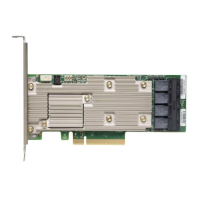- 7 -
ThinkSystem RAID 930-16i 8GB Flash PCIe 12Gb/s Adapter Installation and User Guide
Version 1.0
Chapter 2: Overview
PCIe Host Interface
Serial general-purpose input output (SGPIO) (sideband)
DataBolt bandwidth optimizer technology support for compatible expander-based enclosures
Shield state drive diagnostic technology
2.2 PCIe Host Interface
The adapter has eight PCIe PHYs, which provide host-side maximum transmission and reception rates of 64Gb/s (8Gb/s
per PHY). The adapter uses a packet-based communication protocol to communicate over the serial interconnect.
Other PCIe host interface features include:
Eight PCIe host lane interface
Power management
— Supports the PCI Bus Power Management Interface Specification, Revision 1.2
— Supports Active State Power Management by placing links in a power-saving mode during times of no
link activity
Error handling
High bandwidth per pin with low overhead and low latency
Lane reversal and polarity inversion
Single-phy (one-lane) link transfer rate of 8GT/s, 5GT/s, and 2.5GT/s in each direction
Eight-lane aggregate bandwidth of up to 8GB/s (8000MB/s)
Support of x8, x4, x2, and x1 link widths
2.3 Operating System Support
To check for the latest list of supported operating systems and to download the device drivers for those operating
systems, go to http://support.lenovo.com.
2.4 Adapter Characteristics
2.4.1 Flash Memory
The adapter supports data retention by using NAND flash memory down on the adapter, backed up by the
ThinkSystem RAID 930 SuperCap.
2.4.2 LEDs
The adapter supports an LED that indicates activity on the drives connected to the adapter and an LED that indicates
whether a drive is in a fault condition. The SGPIO supports SAS/SATA LED management. The SFF-8485 specification
describes the functionality.
Refer to the Lenovo ThinkSystem Storage Adapter Software User Guide for more information about actions you can take
related to the LEDs.

